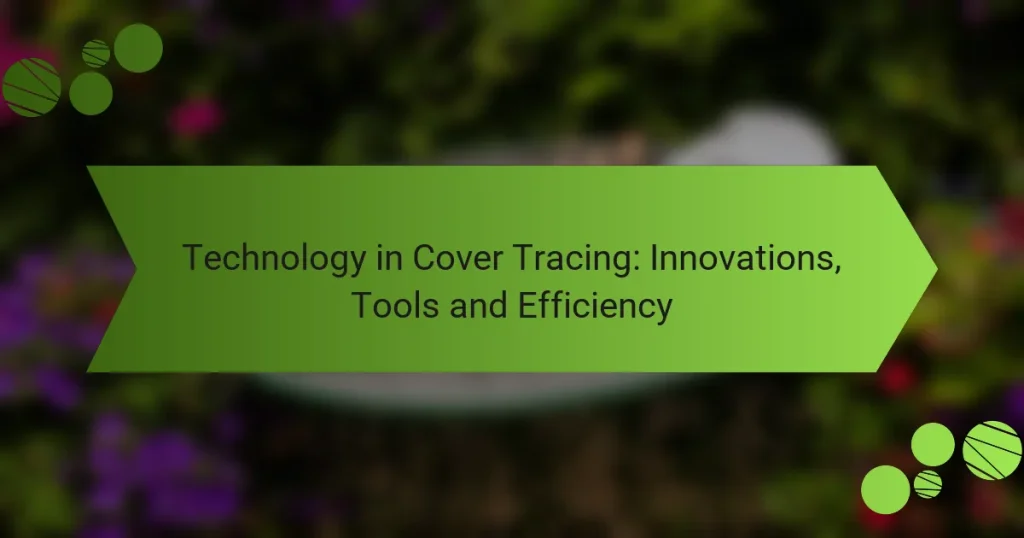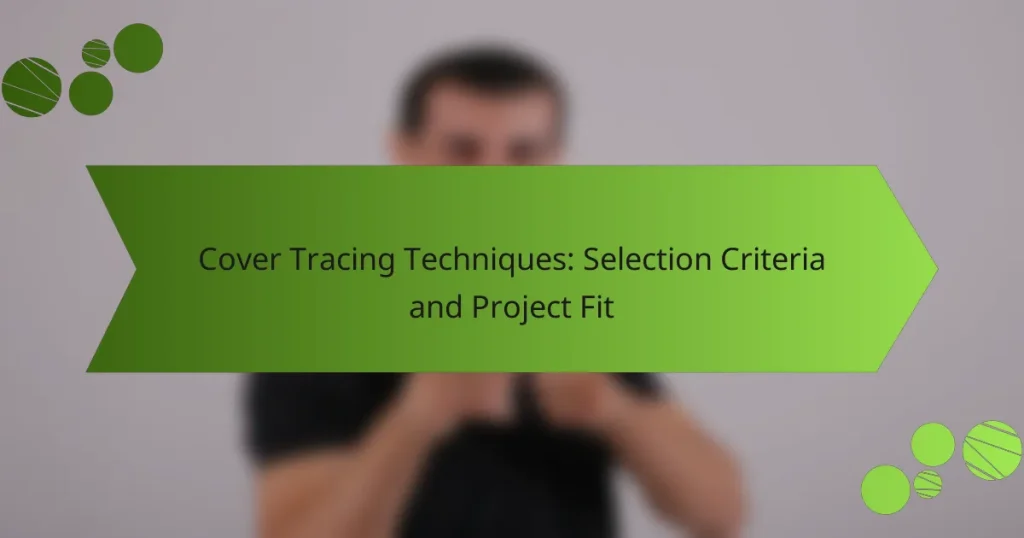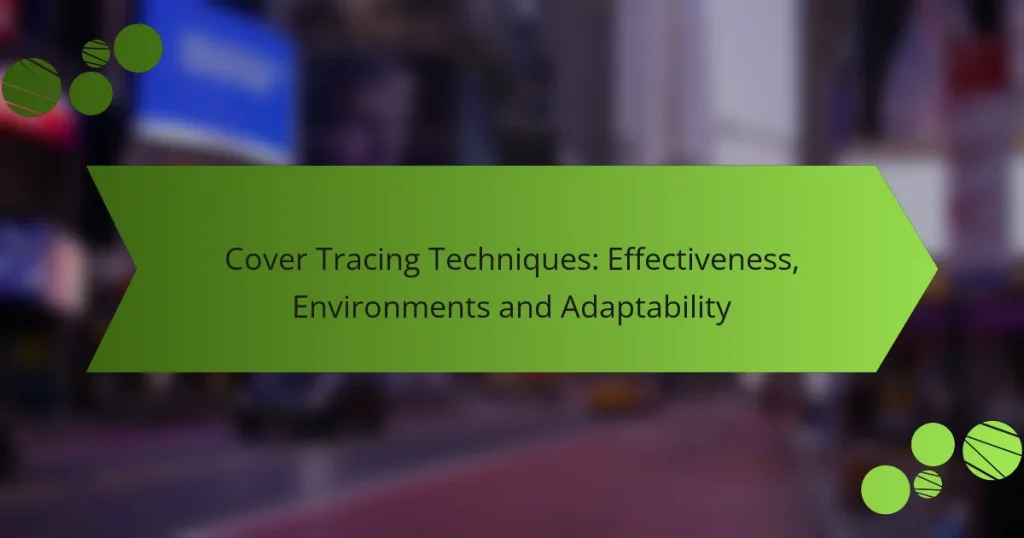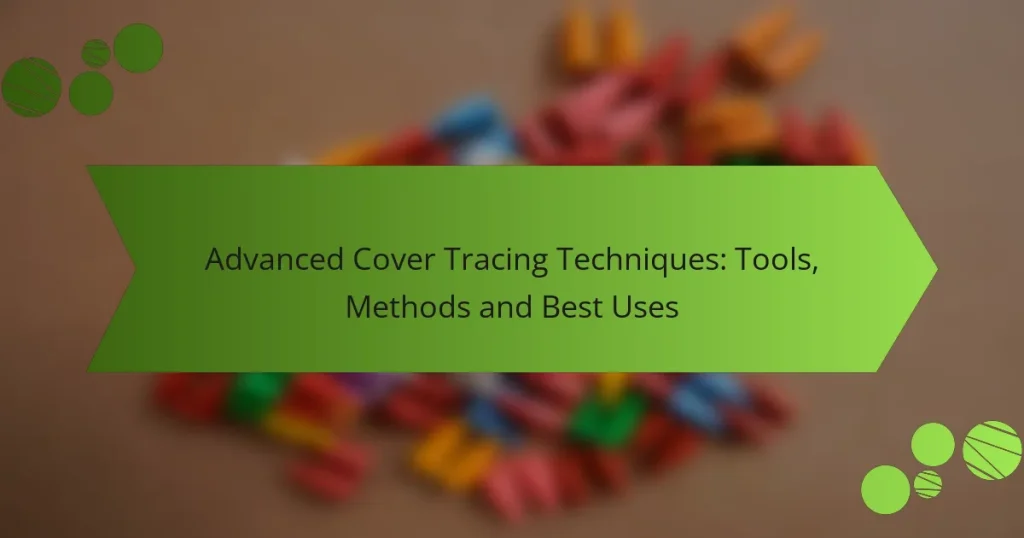Cover tracing techniques are essential for accurately reproducing designs, and they can be categorized into digital, manual, and hybrid methods. Each technique offers distinct advantages, such as precision, speed, and resource efficiency, making it crucial to choose the right approach based on the specific needs of a project.
Technology in Cover Tracing: Innovations, Tools and Efficiency
Cover Tracing Techniques: Selection Criteria and Project Fit
Cover Tracing Techniques: Effectiveness, Environments and Adaptability
Cover Tracing Techniques: Top 5 for DIY Enthusiasts
Cover Tracing Techniques: Cost Analysis, Value and Budget Options
Advanced Cover Tracing Techniques: Tools, Methods and Best Uses
What are the best cover tracing techniques?
The best cover tracing techniques include digital, manual, and hybrid methods, each offering unique advantages and considerations. Selecting the right technique depends on factors like accuracy, speed, and available resources.
Digital cover tracing
Digital cover tracing utilizes software tools to create precise outlines of covers. This method is often faster and allows for easy adjustments, making it ideal for projects requiring high accuracy and efficiency.
Common software options include Adobe Illustrator and CorelDRAW, which offer various features for vectorization and editing. Users should ensure they are familiar with the software to maximize its capabilities.
Manual cover tracing
Manual cover tracing involves physically outlining covers using traditional tools like pencils and tracing paper. This technique can be beneficial for artists who prefer a hands-on approach and want to maintain a personal touch in their work.
While it may take more time compared to digital methods, manual tracing allows for greater creative freedom. However, it is essential to have a steady hand and good lighting to achieve clean lines.
Hybrid cover tracing
Hybrid cover tracing combines both digital and manual techniques, offering flexibility and versatility. This approach allows artists to start with manual sketches and then refine them digitally for precision.
Using a tablet or scanner can facilitate this process, enabling a smooth transition between the two methods. Artists should consider their workflow preferences and the specific requirements of their projects when choosing this technique.
How does digital cover tracing work?
Digital cover tracing involves creating a precise outline of a design or image using software tools. This technique allows for the replication and modification of graphics in a digital format, making it essential for various applications, including graphic design and printing.
Software tools for digital tracing
Several software tools are available for digital cover tracing, each offering unique features. Popular options include Adobe Illustrator, CorelDRAW, and Inkscape, which provide robust tracing capabilities and user-friendly interfaces. These tools often support various file formats, allowing for easy import and export of designs.
When selecting a tool, consider factors such as ease of use, available features, and compatibility with your operating system. For instance, Adobe Illustrator is widely used in professional settings, while Inkscape is a strong free alternative for beginners.
Steps in digital cover tracing
The process of digital cover tracing typically involves several key steps. First, import the image you wish to trace into your chosen software. Next, use the tracing tool to outline the main shapes and details of the image, adjusting settings for accuracy and smoothness.
After tracing, refine the paths and shapes to ensure they match the original design closely. Finally, save your work in the desired format, such as SVG or PNG, for further use. Common pitfalls include neglecting to zoom in for detail work and not saving backups during the process.
What are the advantages of manual cover tracing?
Manual cover tracing offers several advantages, including enhanced control over precision and cost savings. These techniques allow for detailed adjustments that can lead to more accurate results compared to automated methods.
Precision in manual techniques
Manual cover tracing is known for its high level of precision. By using tools like rulers, compasses, and protractors, tracers can achieve exact measurements and angles that automated systems may overlook. This meticulous approach is particularly beneficial in fields such as architecture and engineering, where small discrepancies can lead to significant issues.
To ensure precision, it’s essential to maintain a steady hand and a clear line of sight. Regular practice can improve skill levels, allowing for faster and more accurate tracing over time. Using high-quality materials, such as fine-tip pens and sturdy paper, can also enhance the overall precision of the work.
Cost-effectiveness of manual tracing
Manual cover tracing is often more cost-effective than automated alternatives, especially for smaller projects. The initial investment in tools is relatively low, and ongoing costs are minimal compared to software subscriptions or machinery maintenance. This makes manual tracing an attractive option for freelancers and small businesses.
However, while manual techniques save on equipment costs, they may require more time to complete tasks. It’s important to weigh the time investment against the financial savings. For projects with tight deadlines, consider the trade-off between speed and cost to determine the best approach.
What tools are used for cover tracing?
Cover tracing typically involves graphic design software that allows users to create precise vector graphics from raster images. The most common tools for this purpose include Adobe Illustrator and CorelDRAW, each offering unique features suited for different design needs.
Adobe Illustrator for tracing
Adobe Illustrator is a powerful tool for cover tracing, known for its advanced vectorization capabilities. Users can utilize the Image Trace feature to convert bitmap images into scalable vector graphics, allowing for high-quality prints without loss of detail.
When using Illustrator, consider adjusting the tracing settings to achieve the desired level of detail. Options like ‘Low Fidelity’ or ‘High Fidelity’ can significantly affect the final output. A common practice is to start with a high-fidelity trace and then simplify the paths as needed for cleaner designs.
CorelDRAW for cover design
CorelDRAW is another popular choice for cover tracing, particularly favored for its user-friendly interface and robust design tools. It features a PowerTRACE function that allows users to convert bitmap images into vector graphics efficiently.
In CorelDRAW, take advantage of the various preset options for tracing, which can save time and enhance productivity. Users should also be mindful of the color modes; using CMYK is essential for print designs to ensure accurate color reproduction. Regularly saving your work in different formats can help maintain quality and flexibility in your design process.
How to choose the right cover tracing technique?
Selecting the appropriate cover tracing technique depends on the specific requirements of your project, including accuracy, speed, and the type of materials involved. Consider the context in which the tracing will be applied, as well as the available tools and resources.
Factors to consider
When choosing a cover tracing technique, evaluate factors such as the precision needed, the complexity of the design, and the materials being used. For instance, if high accuracy is crucial, techniques like digital tracing may be preferable, while simpler projects might benefit from manual methods.
Additionally, consider the time constraints and budget. Some techniques may require specialized equipment or software, which can increase costs. Assess whether the investment aligns with the project’s goals.
Comparative analysis of techniques
Different cover tracing techniques offer various advantages and disadvantages. Manual tracing is often more accessible and cost-effective but may lack the precision of digital methods. On the other hand, digital tracing can produce high-quality results quickly but may require a learning curve and investment in software.
For example, if you are working with intricate designs, digital tracing software can save time and enhance accuracy. Conversely, for straightforward designs or when working with limited resources, manual tracing might suffice. Always weigh the trade-offs based on your specific needs and constraints.
What are common mistakes in cover tracing?
Common mistakes in cover tracing can lead to inaccuracies and inefficiencies. Key errors include ignoring resolution settings and over-relying on software tools, both of which can compromise the quality of the tracing process.
Ignoring resolution settings
Ignoring resolution settings can result in poor-quality outputs. When tracing covers, it is crucial to set the appropriate resolution, typically between 300 to 600 DPI, to ensure clarity and detail in the final product.
Higher resolutions capture more detail but also increase file size, which can slow down processing. Always balance the need for quality with the limitations of your software and hardware capabilities.
Over-reliance on software
Over-reliance on software can diminish the effectiveness of cover tracing. While software tools can automate many tasks, they may not always account for nuances in design or specific requirements of the project.
It’s essential to combine software capabilities with manual adjustments and artistic judgment. Regularly review the output and make necessary tweaks to ensure the final tracing meets your standards and expectations.
What are the emerging trends in cover tracing?
Emerging trends in cover tracing include the use of advanced technologies that enhance accuracy and efficiency. These trends are reshaping how cover tracing is performed, making it more accessible and effective for various applications.
AI-driven tracing solutions
AI-driven tracing solutions leverage machine learning algorithms to analyze data and improve the accuracy of cover tracing. These systems can process large datasets quickly, identifying patterns and anomalies that traditional methods might miss.
For instance, AI can automate the tracing process, reducing the time required from hours to mere minutes. Organizations adopting these solutions often see improvements in efficiency and a decrease in human error, making them a valuable investment.
Integration with augmented reality
Integrating augmented reality (AR) with cover tracing enhances visualization and user interaction. AR applications allow users to overlay digital information onto the physical environment, providing real-time insights during the tracing process.
This technology can be particularly useful in fields like construction and maintenance, where users can visualize underground utilities or structural elements directly on-site. By using AR, teams can make more informed decisions and reduce the risk of costly mistakes.






